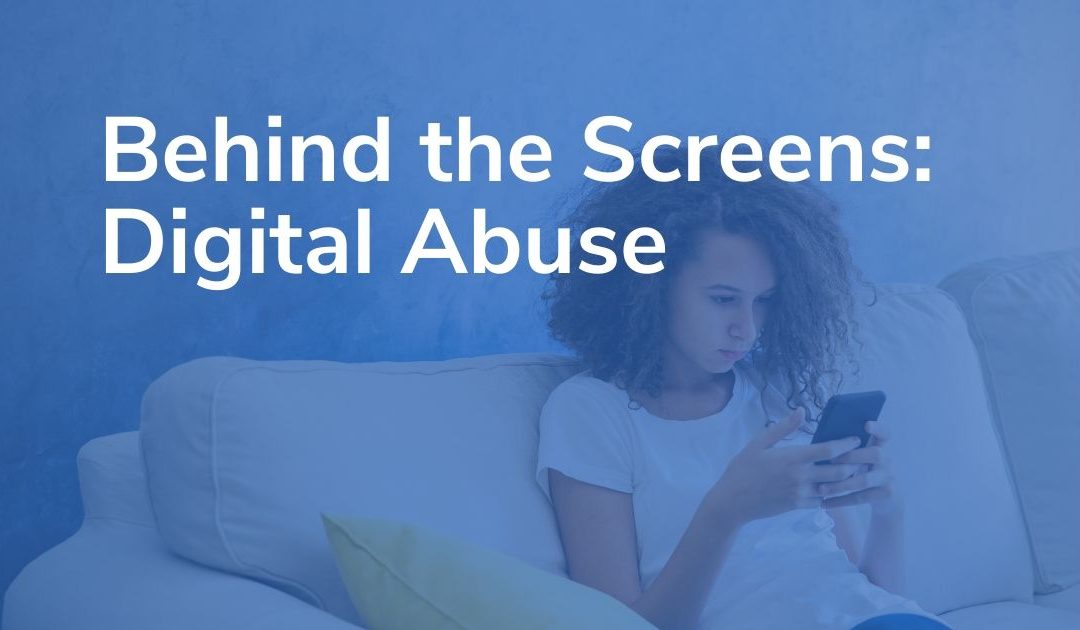Behind the Screens: Digital Abuse
By Lesley Coghill, LMSW
The predominant way for us to pull together during this period of social distancing is to connect online and through technology. The world is staying connected by sharing fun videos, having Zoom meetings and virtual gatherings, sharing our artistic creativity, and lifting others up with encouragement and well wishes in order to overcome our sense of isolation. My neighbors have all been daring one another to take the ice bucket challenge and posting their hilarious videos to Facebook. Technology helps us to feel connected when we cannot be face-to-face with those we love and care about.
Technology can also be misused at times and we see this happen often within the context of domestic violence and dating violence. One partner may attempt to gain control through perpetrating digital abuse by monitoring, harassing, intimidating, stalking, sexually pressuring, or verbally and emotionally abusing their partner through the use of technology. This may further isolate, humiliate, and limit the mobility of the survivor. Young people in dating relationships are especially prone to this type of abuse.
According to the Urban Institute, 25% of dating teens in a 2013 study reported they’ve been digitally victimized by their partners. Teens in this study who experienced digital abuse were at higher risk for experiencing other forms of dating abuse, including psychological abuse, physical abuse, and sexual coercion.
What concerning behaviors might we notice when someone is experiencing digital abuse? How might this be exacerbated during this time of social distancing?
Using Isolation and Control. Many people thoroughly enjoy spending hours on social media and online connecting with their friends or partner, especially during a time when we are staying away from in-person gatherings. An abusive partner may use technology to try to gain control over their partner by socially isolating and preventing their partner from communicating with other people. This may look like preventing one’s partner from calling, texting, or video chatting with their loved ones, which may be someone’s lifeline to the outside world during this time.
Maybe an abusive partner insists on having constant contact through technology. An abusive partner might insist that the survivor immediately respond to texts messages and DMs or demand that the survivor Facetime with them throughout the day so that the abusive partner can see what they are doing and control who else the survivor talks to. Limiting a partner’s time with other friends and family (even online or through text) monopolizes the survivor’s time and further isolates them from the people who care for their best interest. The abusive partner may do this out of their own unjustified jealousy and need for control.
Monitoring and Stalking. A partner may demand access to social media accounts, hijack social media accounts and pose as the survivor to see who they are talking to online, or otherwise attempt to monitor, humiliate, stalk, or abuse the survivor through technology. Insisting on constant contact or requiring a partner to sleep with their phone in order to have access to them at all hours is an abusive monitoring behavior. Additionally, using GPS or other apps to virtually track and monitor someone is a form of stalking. Platforms like Snapchat allow for temporary posts that disappear and are difficult to trace. An abusive partner may mistakenly believe that since the survivor’s whereabouts are known during the pandemic (they are not attending school or going to work) that they are entitled to have digital access to their partner.
With nearly seventeen years of experience working with young teens, a popular excuse I frequently hear as a justification for this abusive and unhealthy monitoring behavior is if they believe their partner is “cheating”. There is no excuse for violating a partner’s privacy, space, and autonomy. Abusive partners often use blame and unfounded accusations of cheating against a survivor to shift blame and further socially alienate and discredit them. A healthy way to address cheating is to directly communicate your feelings to that partner, stating how you would like to be treated with respect and that you value faithfulness and honesty. Have an open conversation with that partner about your concerns.
Coercion and Sexting Pressure. According to the 2019 Ottawa County Youth Assessment Survey, 24% of the 6,674 respondents in 8th-12th grade reported that they had engaged in a “sexting” activity in the prior year. When sexting activities are pressured, someone might demand that their partner send or post nude photos or share explicit text messages. Sexting is harmful when it is coercive, manipulative, threatening, or in any way not consensual, in addition to the obvious life changing consequences (e.g. child pornography charges, being on the sex offender registry, and social and emotional impacts, etc.). An abusive partner might use guilt trips and threats to sexually pressure through digital tactics. For example, during a stay-at-home order, a partner might not be satisfied with a virtual dating relationship and not respect their partner’s social distancing safety measures by insisting on a physical relationship and threatening a breakup if they don’t get their way.
How can parents support and empower teens who are experiencing digital abuse?
- Respond with love. Express how much you care for their safety and well-being.
- Listen with empathy and support. Believe their experiences without judgement.
- Reinforce what healthy and respectful relationships should look and feel like.
- Share resources with your teen. Watch healthy relationship videos or look at websites together.
Digital Abuse Resources:
Description: https://www.loveisrespect.org/pdf/What_Is_Digital_Abuse.pdf
Webpage for Teens with interactive games: https://thatsnotcool.com/
Statistics & Infographic: https://www.urban.org/features/teen-dating-abuse-digital-age
The Signs video: https://vimeo.com/85676862
